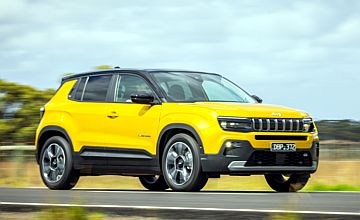Make / Model Search
OptionsCar reviews - Jeep - AvengerJeep modelsOverviewWe like As promised driving range; useful ADAS technologies; straightforward connectivity Room for improvement Price; wind and rear suspension noise; plasticky interior decor; repair kit spare wheel The new Avenger is a useful around-town EV, but is it worth the $61K asking price?27 Jan 2025 By MATT BROGAN Overview
AT A smidge over four metres in length the compact Jeep Avenger is, well, compact. But that’s not to say it isn’t sufficiently useful – especially as an around-town option.
Rivalling both traditionally powered Light segment SUVs like the Kia Stonic, Mazda CX-3, Nissan Juke, and Volkswagen T-Cross, and electric models including the BYD Atto 3, Chery Omoda E5, and Leapmotor C10, the Jeep Avenger is an all-electric alternative that offers blocky styling, practical packaging, and useful levels of technology and connectivity.
The Polish-built and front-wheel driven Avenger is available in three trim grades – Longitude, Limited and Summit – and will deliver a claimed driving range of 390km from its standard 54kWh battery.
Average energy consumption is rated at 15.8kWh per 100km – almost bang-on what we achieved on test.
DC fast charging at up to 100kW is possible, allowing for a 20 to 80 per cent charge time of 24 minutes. A full AC charge takes just under eight hours (at 7kW).
Built on Stellantis’ e-CMP2 platform, the Jeep Avenger is powered by a single ‘M3’ electric motor producing 115kW of power and 260Nm of torque claimed to provide a 0-100km/h acceleration time of 9.0 seconds.
The model offers 200mm of ground clearance and a 10.5m turning circle and tips the scale from 1520kg. It is not rated to tow.
Standard equipment on the entry grade Avenger Longitude (from $49,990 plus on-road costs) includes 17-inch alloy wheels, adaptive cruise control, autonomous emergency braking, cloth upholstery, lane keeping assist, LED headlights, rear parking sensors, and a 7.0-inch digital instrument display.
Connectivity duties fall to a 10.25-inch touchscreen array with six-speaker sound, and wireless Apple CarPlay and Android Auto connectivity.
For the mid-tier Avenger Limited grade (rom $54,990 +ORC), we find additions such as blind-spot monitoring, cloth/synthetic leather upholstery, front and side parking sensors, keyless entry and start, lane centring assist, a powered tailgate, rear-cross traffic alert, and a larger 10.25-inch instrument display.
The range-topping Avenger Summit (tested here, from $60,990 +ORC) adds diamond cut 18-inch alloys (with a repair kit in lieu of a spare wheel), heated front seats, leather-accented upholstery, LED tail-lights, a power-adjustable and massaging driver’s seat, projector-style LED headlights, rear privacy glass, and a sunroof.
Available colour choices include Granite (Silver), Lake (Green), Ruby (Red), Snow (White), Stone (Grey), Sun (Yellow), and Volcano (Black). A black roof can be optioned on selected trim variants. Premium paint is a $990 option.
The Avenger requires servicing every 12 months or 12,500km (whichever comes first). Service costs are listed at $250 per visit. Lifetime roadside assistance is provided when the Avenger is serviced via a Jeep dealer.
The high voltage battery is warranted for eight years or 160,000km while the vehicle is backed by the same five-year/100,000km warranty as the remainder of the Jeep line-up.
Driving Impressions
From the kerb, the Avenger is an attractive, if blocky, SUV with a sense of ruggedness to its front-end. Its compact dimensions are well disguised, the model appearing bigger than the spec’ sheet would otherwise suggest (4084mm long by 1797mm wide by 1534mm high).
Inside, the plasticky interior is quite compact. It provides seating for five (four comfortably) and 355 litres of cargo space with the 60:40 split-fold rear bench in place. The front seats are adequately proportioned, but the rear is a little tight, further detracted upon by the omission of rear seat ventilation outlets.
That said, the generous console storage bin, useful door pockets and deep glove box give the Avenger a pragmatic edge many in the class can’t match.
On the dashboard, we find dual 10.25-inch screens with Jeep’s Uconnect infotainment array front and centre. It offers remote access functionality, AM/FM/DAB+ radio reception, Apple CarPlay and Android Auto connectivity, et al. It is quite simple to use with hard buttons that allow you to return quickly to the home screen.
Additional hard buttons offer easy access to climate control settings which we appreciated when on the move. Couple this with driver assistance and adaptive cruise control technology that helps, not hinders, the Avenger’s interface makes a somewhat welcomed change from others in the segment.
We say somewhat because we found the transmission selector a tad clumsy and slow to respond. Changing direction when parking is tedious, the P-R-N-D/B buttons stretched horizontally across the centre stack quite counterintuitive when jumping in from other cars.
On the move, the Avenger offers progressive acceleration sufficient for its application. The various drive modes did little to change response, our week with the vehicle left predominantly in Normal mode and with generous use of the ‘B’ (or braking) setting from the transmission.
Unfortunately, we feel the steering is over-assisted and quite disconnected in terms of its communication with the driver, which detracts from the Avenger’s otherwise confident handling.
Ride comfort is acceptable given the variants larger wheel and tyre combination, and tyre noise well attenuated. A pity we can’t say the same for wind rustle, which is evident across the blocky cabin at speeds over 70km/h.
It was also disheartening to hear some knocking from the rear suspension when countering larger bumps.
In coming to rest, the Avenger offers decent stopping power from four-wheel discs, but like many electric vehicles lacks naturality in its pedal stroke. We also reckon the pedal could use a little more assistance, feeling a touch heavy and with more travel than is ideal in around-town use.
But perhaps what impressed us most about the Jeep Avenger Summit was its ability to live up to the manufacturer’s range claims.
Sure, energy consumption of 15.8kWh per 100km might not be class-leading – especially for a $61K vehicle – but in religiously adhering to that number, and returning a driving range of 390km, we are as satisfied as can be expected.
Like any new car – and especially any new electric car – we would thoroughly recommend a test drive before you sign on the dotted line.
There are plenty of alternatives in the Light and Small electric SUV segments that offer more for the money than the Jeep Avenger.
As handsome and as fuss-free as it might be, we just can’t help but feel there are far better deals to be had, including those from BYD (Atto 3 from $44,500) Chery (Omoda E5 from $42,990), Hyundai (Kona Electric from $54,000), Kia (Niro EV from $45,000), Tesla (the larger Model Y is available from $55,900), and Volvo (EX30 from $59,990).  Read more6th of December 2024  Six new energy vehicles get five ANCAP starsSix electrified models win top marks at ANCAP but Jeep and MG miss the mark6th of September 2024  Jeep drops Avenger price ahead of arrivalIncoming Jeep Avenger BEV price cut trimmed, now sneaking in at under $50,0003rd of June 2024  Big, fully electric Jeep on the wayJeep’s first global BEV, the Wagoneer S large SUV, confirmed to hit Australia in 202614th of March 2024  Jeep Avenger here Q3 priced from $53,990All-electric Jeep Avenger in showrooms by year’s end, pricing and specification announcedAll car reviews Alfa Romeo Alfa Romeo Abarth Abarth Audi Audi Aston Martin Aston Martin BMW BMW Bentley Bentley Chrysler Chrysler Chevrolet Chevrolet Dodge Dodge Citroen Citroen Ferrari Ferrari DS DS Ford Ford Fiat Fiat FPV FPV Foton Foton Haval Haval Great Wall Great Wall Honda Honda Holden Holden Hyundai Hyundai HSV HSV Isuzu Isuzu Infiniti Infiniti Jaguar Jaguar Iveco Iveco Kia Kia Jeep Jeep Land Rover Land Rover Lamborghini Lamborghini Maserati Maserati Lexus Lexus McLaren McLaren Mazda Mazda Mercedes-Benz Mercedes-Benz Mitsubishi Mitsubishi Mini Mini Opel Opel Nissan Nissan Porsche Porsche Peugeot Peugeot Ram Ram Proton Proton Rolls-Royce Rolls-Royce Renault Renault Skoda Skoda Saab Saab SsangYong SsangYong Smart Smart Suzuki Suzuki Subaru Subaru Toyota Toyota Tesla Tesla Volvo Volvo |
OptionsClick to share
|











Facebook Twitter Instagram